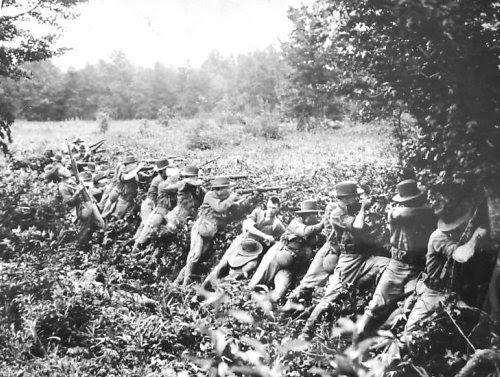In October 1899, the Americans launched a campaign intended to cut Emilio Aguinaldo’s northward retreat and trap his remaining conventional forces. The 3-pronged attack consisted of Lawton’s command (red and green lines) moving northeastward to cut off any possibility of Aguinaldo’s army heading east to take refuge in the mountains; Wheaton’s command (light blue line) steaming from Manila around the northwestern edge of Luzon, coming through Lingayen Gulf and landing at San Fabian, Pangasinan Province, to block roads heading north; and MacArthur’s command (dark blue line) moving northwestward along the Manila-Dagupan railroad from Angeles to Dagupan, Pangasinan Province, to push Aguinaldo into the pocket created by Lawton’s and Wheaton’s forces.
Often portrayed as either a continuation of the conquest of the western frontier or a precursor to Vietnam, the American pacification of the Philippines is more accurately interpreted in the context of the 19th-century wars of imperial conquest. Superior weaponry, training, leadership, and logistics allowed a numerically small Western force to overcome a more numerous but internally divided resistance. What made the American accomplishment notable was the development of an effective pacification strategy that combined chastisement and conciliation.
The Military Conquest of the Philippines
The outbreak of the Spanish–American War on April 25, 1898, was followed almost immediately by the U.S. defeat of the Spanish naval squadron at the battle of Manila Bay on May 1. Comm. George Dewey’s small fleet dealt a crippling blow to Spanish power and ignited widespread Filipino uprisings throughout the Philippines. Many of these movements were headed by local elites and had little connection to the earlier independence movement directed by the exiled Emilio Aguinaldo. Although Aguinaldo returned on June 23 and proclaimed his leadership of a revolutionary government dedicated to Philippine independence, his actual control was largely confined to south and central Luzon. As Spanish authority collapsed, Pres. William McKinley, seeking to exploit Dewey’s success and unaware of the local situation, ordered an American military expedition to capture the capital city of Manila. The first troops arrived in Manila Bay on June 30 and were rapidly increased to some 14,000, sufficient to take Manila against desultory Spanish resistance on August 13.
The Battle of Manilla on February 4, 1899.
The military occupation of Manila alienated Aguinaldo, who sought to maintain a siege of the American forces at the same time he consolidated his military and political power. For his part, McKinley kept his ultimate intentions toward the Philippines unclear until December, when he instructed the commissioners negotiating peace with Spain to demand the entire archipelago. Although historians still debate his real motives, McKinley justified acquisition largely in moral terms: the United States had an obligation to bring economic prosperity, social justice, and peace to the Filipino people. However, his December 21, 1898, proclamation, while declaring that the nation’s goal was one of “benevolent assimilation,” made clear that U.S. authority would be extended throughout the archipelago, by force if necessary. Aguinaldo and his supporters proclaimed the formation of the Philippine Republic on January 20, 1899, but the government was national in name only. Outside of Luzon, insurgent leaders gave either little or no allegiance to Aguinaldo and they, in turn, were given virtually no representation in his government. Neither Aguinaldo nor the local civil and military authorities that wielded actual power sought to include the peasantry, who made up the vast majority of the population. The elitist character and objectives of the nationalist leaders weakened Filipino popular support for the revolution.
Relations between Aguinaldo and the U.S. Army rapidly deteriorated after the occupation of Manila and McKinley’s December declaration. After a number of incidents, fighting broke out on the night of February 4, 1899, and for the next 10 months U.S. and Filipino conventional forces struggled for control of Luzon. In the second battle of Manila (February 4–22, 1899), American forces under the command of Maj. Gen. Elwell S. Otis drove Aguinaldo’s army back from the capital, inflicting crucial losses in matériel and personnel. Two successful offensives in March captured the Republic’s capital of Malolos and cut Aguinaldo’s army in two. In late April, a sustained offensive into central Luzon almost destroyed what remained of the rebels, but a combination of weather, disease, poor communications, and logistical problems allowed the demoralized Filipino forces to escape. The summer monsoon led to a halt in major conventional operations on Luzon and the relief of the state volunteers who had enlisted to fight Spain.
In October, reinforced by a newly recruited federal volunteer force, Otis launched a three-pronged attack designed to encircle Aguinaldo’s army. Two divisions drove north, pinning the insurgents’ main force, while an amphibious brigade landed at Lingayen Gulf to block its retreat. On November 13, 1899, Aguinaldo ordered the remnant of his army to scatter, return to their homes, and take up guerrilla warfare. Although his rear guard was destroyed on December 2, he escaped into the mountains of northern Luzon. With the main insurgent conventional forces scattered, in January and February 1900 American expeditions conquered the area south of Manila and occupied most of the major ports in the Visayan Islands. Believing that no effective armed resistance remained, Otis reorganized his tactical units into operational forces and spread them throughout the archipelago. The Army’s objective was to prepare the way for U.S. colonial government by imposing law and order, reviving the economy, and winning over the population.
